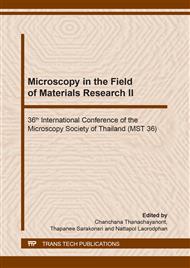[1]
Libo. Y, Bohumil. K, Liang Huang, A review of recent research on the use of cellulosic fibres, their fibre fabric reinforced cementitious, geo-polymer and polymer composites in civil engineering, Composites Part B. 2016; 92:94-132.
DOI: 10.1016/j.compositesb.2016.02.002
Google Scholar
[2]
Yan L, Chouw N, Jayaraman K. Effect of triggering and polyurethane foam filler on axial crushing of natural flax/epoxy composite tubes. Materials & Design 2014; 56:528-541.
DOI: 10.1016/j.matdes.2013.11.068
Google Scholar
[3]
Yan L, Chouw N. Crashworthiness characteristics of flax fibre reinforced epoxy tubes for energy absorption application. Materials & Design 2013; 51:629-40.
DOI: 10.1016/j.matdes.2013.04.014
Google Scholar
[4]
Silva FA, Toledo Filho RD. Fairbairn EMR. Physical and mechanical properties of durable sisal fibre-cement composites. Construction and Building Materials 2010; 224(5):777-85.
DOI: 10.1016/j.conbuildmat.2009.10.030
Google Scholar
[5]
Abdullah AC, Lee CC. Effect of treatments on properties of cement-fiber bricks utilizing rice husk, corncob and coconut Coir. Procedia Engineering. 2017; 180:1266 – 1273.
DOI: 10.1016/j.proeng.2017.04.288
Google Scholar
[6]
Khan M, Ali M. Effect of super plasticizer on the properties of medium strength concrete prepared with coconut fiber. Construction and Building Materials. 2018; 182:703–715.
DOI: 10.1016/j.conbuildmat.2018.06.150
Google Scholar
[7]
Lertwattanaruk P, Suntijitto A. Properties of natural fiber cement materials containing coconut coir and oil palm fibers for residential building applications. Construction and Building Materials. 2015; 94:664–669.
DOI: 10.1016/j.conbuildmat.2015.07.154
Google Scholar
[8]
Asasutjarit C J, Hirunlabh J, Khedari S, Charoenvai B, Zeghmati U, Cheul S. Development of coconut coir-based lightweight cement board, Construction and Building Materials. 2005; 21: 277–288.
DOI: 10.1016/j.conbuildmat.2005.08.028
Google Scholar
[9]
Asasutjarit C, Charoenvai S, Hirunlabh J, Khedari J. Material and mechanical properties of pretreated coir-based green composites, Composites Part B. 2009;40(7): 633–637.
DOI: 10.1016/j.compositesb.2009.04.009
Google Scholar
[10]
Kriker A, Debicki G, Bali A, Khenfe MM, Chabannet M. Mechanical properties of date palm fibres and concrete reinforced with date palm fibres in hot-dry climate, Cement Concr. Compos. 27 (5) (2005) 554–564.
DOI: 10.1016/j.cemconcomp.2004.09.015
Google Scholar
[11]
Ramakrishna G, Sundararajan T. Impact strength of a few natural fibre reinforced cement mortar slabs: a comparative study, Cement and Concrete Composite. 2005; 27(5): 547–553.
DOI: 10.1016/j.cemconcomp.2004.09.006
Google Scholar
[12]
Ashori A, Tabarsa T and Sepahvand S. Cement-bonded composite boards made from poplar strands. Construction and Building Materials. 2012; 26: 131-134.
DOI: 10.1016/j.conbuildmat.2011.06.001
Google Scholar
[13]
Asasutjarit C, Hirunlabh J, Charoenvai S. Zeghmati B. Development of coconut coir-based lightweight cement board. Construction and Building Materials. 2007;21: 277-288.
DOI: 10.1016/j.conbuildmat.2005.08.028
Google Scholar
[14]
Rajamane NP, Annie PJ and Ambily PS. Prediction of compressive strength of concrete with fly ash as sand replacement material. Cement and Concrete Composites. 2007;29: 218-223.
DOI: 10.1016/j.cemconcomp.2006.10.001
Google Scholar
[15]
Alida A, Shamsul B J, Mazlee M N, Kamarudin H. Composite Cement Reinforced Coconut Fiber: Physical and Mechanical Properties and Fracture Behavior, Australian Journal of Basic and Applied Sciences 2011;5(7): 1228-1240.
Google Scholar
[16]
Dale PB, Max AP, John P. The influence of water-to-cement mass ratio (w/c) on early-age properties of cement-based materials is investigated using a variety of experimental techniques. ASCE Journal of Materials in Civil Engineering, 2009;21: 512-517.
DOI: 10.1061/(asce)0899-1561(2009)21:9(512)
Google Scholar
[17]
Monica A, Josep C, Romildo DTF. Cellulosic fiber reinforced cement-based composites: A review of recent Research, Construction and Building Materials. 2015;79: 115–128.
DOI: 10.1016/j.conbuildmat.2015.01.035
Google Scholar


